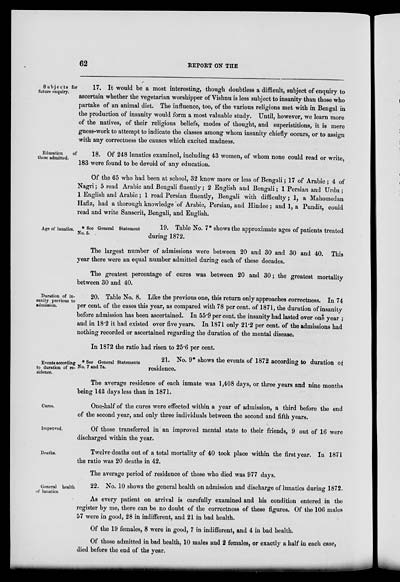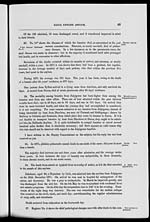Medicine - Mental health > 1867-1924 - Annual report of the insane asylums in Bengal > Insane asylums in Bengal annual reports 1867-1875 > Annual report on the insane asylums in Bengal for the year 1872
(574) Page 62
Download files
Individual page:
Thumbnail gallery: Grid view | List view

62 REPORT ON THE
Subjects for
future enquiry.
17. It would be a most interesting, though doubtless a difficult, subject of enquiry to
ascertain whether the vegetarian worshipper of Vishnu is less subject to insanity than those who
partake of an animal diet. The influence, too, of the various religions met with in Bengal in
the production of insanity would form a most valuable study. Until, however, we learn more
of the natives, of their religious beliefs, modes of thought, and superistitions, it is mere
guess-work to attempt to indicate the classes among whom insanity chiefly occurs, or to assign
with any correctness the causes which excited madness.
Education of
those admitted.
18. Of 248 lunatics examined, including 43 women, of whom none could read or write,
183 were found to be devoid of any education.
Of the 65 who had been at school, 32 knew more or less of Bengali; 17 of Arabic ; 4 of
Nagri; 5 read Arabic and Bengali fluently; 2 English and Bengali; 1 Persian and Urdu;
1 English and Arabic; 1 read Persian fluently, Bengali with difficulty; 1, a Mahomedan
Hafiz, had a thorough knowledge of Arabic, Persian, and Hindee; and 1, a Pundit, could
read and write Sanscrit, Bengali, and English.
Age of lunatics. * See General Statement
No. 5.
19. Table No. 7* shows the approximate ages of patients treated
during 1872.
The largest number of admissions were between 20 and 30 and 30 and 40. This
year there were an equal number admitted during each of these decades.
The greatest percentage of cures was between 20 and 30; the greatest mortality
between 30 and 40.
Duration of in-
sanity previous to
admission.
20. Table No. 8. Like the previous one, this return only approaches corrcetness. In 74
per cent. of the cases this year, as compared with 78 per cent. of 1871, the duration of insanity
before admission has been ascertained. In 55.9 per cent. the insanity had lasted over one year ;
and in 18.2 it had existed over five years. In 1871 only 21.2 per cent. of the admissions had
nothing recorded or ascertained regarding the duration of the mental disease.
In 1872 the ratio had risen to 25.6 per cent.
Events according * See General Statements
to duration of re- No. 7 and 7a.
sidence.
21. No. 9* shows the events of 1872 according to duration of
residence.
The average residence of each inmate was 1,408 days, or three years and nine months
being 142 days less than in 1871.
Cures.
One-half of the cures were effected within a year of admission, a third before the end
of the second year, and only three individuals between the second and fifth years.
Improved.
Of those transferred in an improved mental state to their friends, 9 out of 16 were
discharged within the year.
Deaths.
Twelve deaths out of a total mortality of 40 took place within the first year. In 1871
the ratio was 20 deaths in 42.
The average period of residence of those who died was 977 days.
General health
of lunatics.
22. No. 10 shows the general health on admission and discharge of lunatics during 1872.
As every patient on arrival is carefully examined and his condition entered in the
register by me, there can be no doubt of the correctness of these figures. Of the 106 males
57 were in good, 28 in indifferent, and 21 in bad health.
Of the 19 females, 8 were in good, 7 in indifferent, and 4 in bad health.
Of those admitted in bad health, 10 males and 2 females, or exactly a half in each case,
died before the end of the year.
Set display mode to: Large image | Zoom image | Transcription
Images and transcriptions on this page, including medium image downloads, may be used under the Creative Commons Attribution 4.0 International Licence unless otherwise stated. ![]()
| Permanent URL | https://digital.nls.uk/83379722 |
|---|




